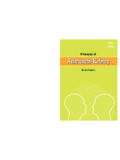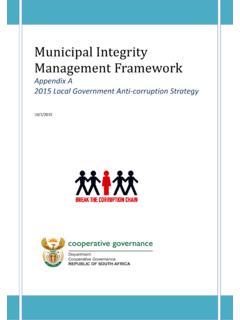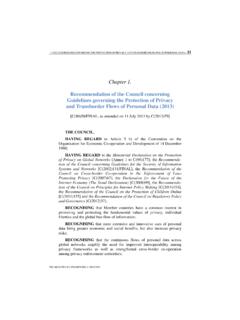Transcription of FAO/INFOODS global food composition database …
1 FAO/INFOODS Databases FAO/INFOODS global food composition database for pulses Version - User guide FAO/INFOODS global food composition database for pulses. Version - User guide Prepared by: Fernanda Grande, Barbara Stadlmayr, Morgane Fialon, Sergio Dahdouh, Doris Rittenschober, T Longvah & U. Ruth Charrondiere food and Agriculture Organization of the United Nations Rome, 2017 The designations employed and the presentation of material in this information product do not imply the expression of any opinion whatsoever on the part of the food and Agriculture Organization of the United Nations (FAO) concerning the legal or development status of any country, territory, city or area or of its authorities, or concerning the delimitation of its frontiers or boundaries.
2 The mention of specific companies or products of manufacturers, whether or not these have been patented, does not imply that these have been endorsed or recommended by FAO in preference to others of a similar nature that are not mentioned. The views expressed in this information product are those of the author(s) and do not necessarily reflect the views or policies of FAO. ISBN 978-92-5-109637-6 FAO, 2017 FAO encourages the use, reproduction and dissemination of material in this information product. Except where otherwise indicated, material may be copied, downloaded and printed for private study, research and teaching purposes, or for use in non-commercial products or services, provided that appropriate acknowledgement of FAO as the source and copyright holder is given and that FAO s endorsement of users views, products or services is not implied in any way.
3 All requests for translation and adaptation rights, and for resale and other commercial use rights should be made via or addressed to FAO information products are available on the FAO website ( ) and can be purchased through Cover photo credits, from left to right: FAO/Samuel Aranda; FAO/Benjamin Rasmussen; FAO/ Ruth Charrondi re Cover illustrations from Neglected crops: 1492 from a different perspective (FAO Plant Production and Protection Series, ). FAO, 1994. Recommended citation: FAO. 2017. FAO/INFOODS global food composition database for Pulses Version - uPulses Rome, FAO. iii Contents Foreword .. v Preface .. vii Acknowledgements .. viii Abbreviations .. ix 1. INTRODUCTION .. 1 Background .. 1 Objectives and principles.
4 1 Outputs .. 3 2. SELECTION OF SPECIES .. 3 3. food ENTRIES INCLUDED .. 3 4. COMPONENTS .. 4 Definition and expression of nutrients .. 4 Proximates and related compounds/ factors .. 4 Minerals .. 6 Fat-soluble vitamins .. 6 Water-soluble vitamins .. 6 Fat-related compounds .. 7 Amino acids .. 7 Phytate .. 8 5. food AGGREGATION AND PRINCIPLES OF IMPUTATION .. 9 6. COOKED FOODS .. 9 7. VALUE DOCUMENTATION .. 11 8. QUALITY CONSIDERATIONS .. 12 9. REFERENCE DATASETS .. 13 10. STRUCTURE OF uPulses .. 14 11. CONCLUSION AND RECOMMENDATIONS FOR FUTURE 15 12. BIBLIOGRAPHY .. 16 ANNEX 1. List of species presented in .. 18 ANNEX 2. List of components presented in 21 ANNEX 3. List of yield factors .. 24 iv Tables Table 1. Metabolizable energy conversion factors.
5 General Atwater factors (FAO, 2003) .. 4 Table 2. New tagnames, description and units used for phytate in uPulses .. 8 Table 3. Nutrient retention factors applied in uPulses .. 10 Table 4. Abbreviations and symbols used in uPulses .. 11 Table 5. List of reference datasets included in uPulses .. 13 Table 6. Datasheets in per 100 g edible portion on fresh weight basis (EP) .. 14 Table Plants that are considered pulses according to FAO (1994) classification .. 18 Table List of components with corresponding infoods tagnames, units, denominators and decimal places .. 21 Table List of amino acids with corresponding infoods component identifier, units and denominators .. 23 Table List of weight yield factors (YF) for pulses .. 24 v Foreword Pulses have recently gained more attention.
6 In 2013, the United Nations General Assembly declared 2016 as the International Year of Pulses (IYP) recognizing the importance of pulses for nutrition, health and agriculture. The food and Agriculture Organization of the United Nations (FAO) was nominated to facilitate the implementation of the IYP in collaboration with Governments, relevant organizations and stakeholders. The IYP aims to increase the awareness on the multiple benefits of pulses for humans and agriculture and thus increase pulse consumption and production. Most countries face some form of malnutrition, ranging from undernutrition and micronutrient deficiencies to obesity and diet-related diseases ( type II diabetes and certain types of cancer).
7 Diet is an important contributor to both health and disease. Pulses are important food crops and should be part of a healthy diet because they are high in protein, fibre, vitamins, minerals and bioactive compounds while being low in fat. Even though pulses were part of many traditional diets, pulse consumption has decreased globally often being replaced by animal products. While this might be a positive trend in countries with a low consumption of animal-based foods it can intensify some malnutrition and health problems in developed countries where animal-based foods are already highly consumed. Pulses however remain an important part of the diets of vegetarians in all countries. In some developed countries, the increased awareness of the environmental and health impact of diets has led to a revival of the interest for pulses.
8 Therefore, raising awareness of the contribution of pulses to food security and nutrition can help countries to improve human health. food composition data for pulses are needed not only to estimate their contribution to nutrient intakes and diet formulations, but also provide background information on the content of pulses that can be taken into consideration to develop, food -based dietary guidelines or food labelling information. Furthermore, accurate information on the nutrient content of locally available foods are needed for the formulation of complementary foods, development of school meals and for nutrition information. In many national or regional food composition tables or databases (FCT/FCDB) pulses are poorly covered and in the international scientific literature reliable compositional data on vitamins and minerals contents of pulses are lacking.
9 A comprehensive database on the composition of pulses was therefore considered important by the International Steering Committee of the IYP. FAO was given the tasks to develop the FAO/INFOODS global food composition database for Pulses. This first edition of the FAO/INFOODS User database for Pulses (uPulses) is one of the legacies of the IYP. The database provides high quality data on the nutrient composition of pulses from a wide variety of species (16 pulse varieties). This database can be used to disseminate nutritional information about pulses to promote its production and consumption and hopefully boost policies and programmes on research and breeding of pulses. Their effectiveness would be enhanced if new analytical data on micronutrient content would be generated and included in uPulses.
10 Anna Lartey Director, Nutrition and food Systems Division FAO, Rome vi vii Preface The International Year of Pulses (IYP) was implemented throughout 2016 and was indeed a very successful year with many activities and media attention worldwide. The main objective of the IYP is to raise awareness of the contribution of pulses to food security, nutrition and health, while contributing to the sustainable management of soils. Pulses have been staple foods for many civilizations for centuries and still are an integral part of the culinary culture. In some parts of the world pulses have a stigma of being a poor person s food and are replaced by meat once people can afford it. Despite all the traditions and actual scientific knowledge, consumers often are unaware of their nutritional and health benefits, therefore greatly undervalue them and do not integrate them into their meal plans.

















